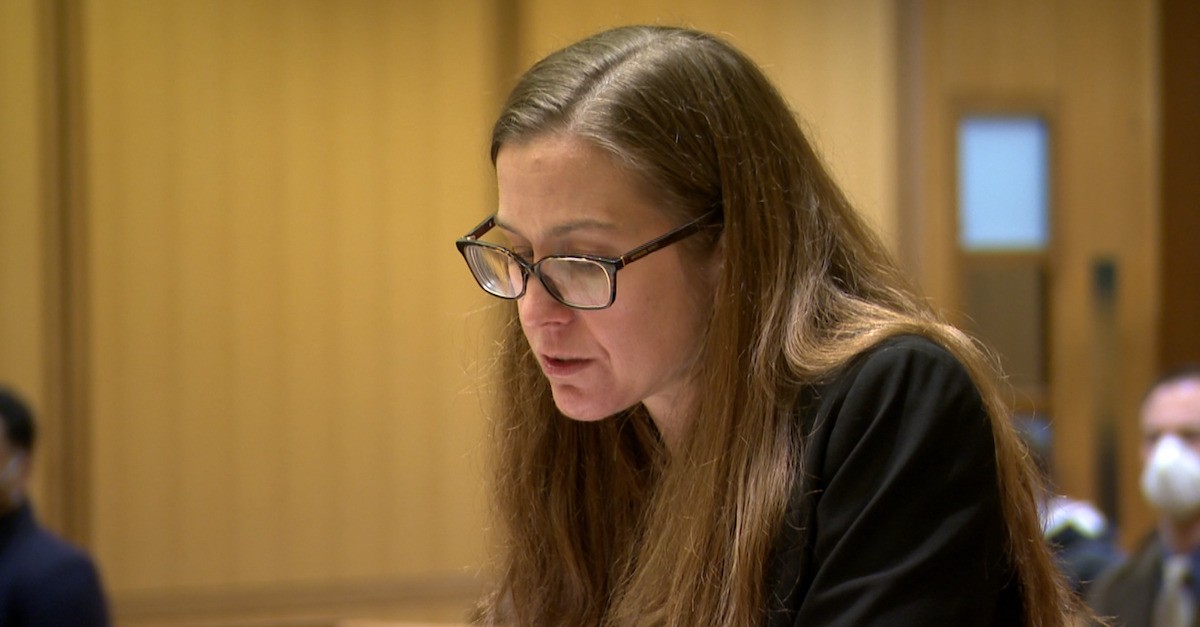
Ellen Wink appears in a Connecticut courtroom in the Stamford-Norwalk judicial district on Feb. 16, 2021. (Image via the Law&Crime Network.)
A former Republican election official who was fired from her job shortly after she was arrested for allegedly murdering a tenant to whom she rented an abode appeared in court on Wednesday — and prosecutors say they have evidence to refute her apparent claims of self defense.
Ellen Wink, 61, of Norwalk, Conn., is charged with shooting and killing Kurt Lametta, 54, on Jan. 20. As Law&Crime previously reported, Lametta was said to have suffered four wounds. Wink, however, apparently said that she fired five shots from a revolver and that Lametta had been “(expletive) driving me nuts.” A witness connected to Wink reportedly said he heard what sounded like a gunshot or gunshots, a pause, and a few more gunshots — possibly evidence that could turn against Wink — but then added that Lametta was “a big bully” and that Wink was “afraid” of him.
A police report obtained by the Stamford Advocate suggested that Wink almost immediately attempted to claim self defense. She reportedly told a 911 dispatcher that Lametta “came” at her when she went to his apartment to clean the abode.
Prosecutor Michelle Manning during a Wednesday court appearance attempted to rubbish any suggestion that the case involved a valid self-defense argument.
“She entered the property of 16 Nelson Avenue with a gun, confronted the tenant, in this case, the victim, Mr. Kurt Lametta, and shot him five times,” Manning said during the Wednesday hearing. “She left the premises and called 911, and the first thing out of her mouth on that 911 call is an indication she came after her.”
Referencing police reports, the prosecutor said Wink “made this allegation that Mr. Lametta was after her” while she was still at the scene of the killing and that Wink claimed “she acted in a self-defense capacity.”
But the investigation continued beyond what the mere assertions of the defendant on the scene.
“What they found was a cell phone video,” Manning continued. “Contained in that video was a recording of the entire incident. The victim in this case had recorded — pressed record on his cell phone — the moment Ms. Wink entered the premises.”
The prosecutor accused Wink of having “walked out” with victim’s phone “as he, essentially, lay dying.”
According to Manning:
The video completely belies any self defense claim. It starts and indicates — it shows, very clearly, a conversation between Mr. Lametta and Ms. Wink — at which point in no way, shape, or form, does the victim come after Ms. Wink. Around three minutes into the video she turns to him, fires a gun, and starts shooting. The victim in the video tries to run away from her, and it’s very clear she follows. It’s also very clear in the video that she picks up the cell phone and threw it outside.
Prosecutors said the latter act appears to have been an attempt to prevent the victim from making a “call for help.”

Assistant State’s Attorney Michelle Manning. (Image via the Law&Crime Network.)
The prosecutor elaborated:
In the state’s view, this video clearly belies any self defense claims as well as indicates a very clear understanding that the defendant is an extreme danger to the community. And, as such, the state feels that the million dollar bond is very small in light of that. That’s really the easiest way to say it, your honor. She presents such a danger to the community that in this moment, on video, she turned and killed a individual who was only nothing to her. The state is asking at this point for a $5 million bond.
Manning noted that the judge who set the initial bond amount — Judge John F. Blawie — did not have the video at the time the $1 million bond was set. Authorities only notified the State’s Attorney’s Office of the video after the arraignment. (Judge Gary White was the official presiding over the Wednesday hearing.)
Defense attorney Stephan Seeger of Stamford said the video does not “eradicate” the defendant’s potential self-defense claim.
“I certainly don’t view the video the same way as the state does,” Wink’s defense attorney said. “There’s a characterization that the entire incident is captured. That, I would disagree with. We don’t know what happens before.”

Ellen Wink and defense attorney Stephan Seeger. (Image via the Law&Crime Network.)
Judge White cut the defense attorney off to agree that the video never tells the “full story” of an incident. The defendant shook her head in agreement.
“One million dollars is a lot of money,” Seeger continued as he referenced the original bond amount. He added that “there’s five shots” and that “it’s a homicide” case. He then balked at the state’s assertion that Wink moved the phone to prevent the victim for calling for help.
“The record makes clear she also made a 911 call,” Seeger noted.
The defense further said that he was unsure whether the state’s evidence technicians “snipped” portions of the video to make his client appear guilty.
Prosecutors sought to torpedo the defense’s attempt to cast doubt on the quality of the video.
“She concocted the story right away in her 911 call that the victim came after her,” Manning countered. The prosecutor also said that the video shows Wink “lied” about the incident being a valid example of self defense:
She indicated that not only to the dispatcher but also to the individual who was in her house as well. You can hear that on the 911 call, that he came after her. It’s very clear in the state’s view that this is a different perception of what was reflected in the initial paperwork and the initial disclosure because of the fact that this video completely negates the fact that there’s a self-defense claim in the state’s view as well as shows she lied about it relatively quickly right after when she called 911. She had already concocted the story.
The defense rebutted that assertion with the following somewhat heated retort:
These facts are totally incommensurate with the story. Mrs. Wink didn’t run anywhere. She stayed where she was. She knew she was going to be arrested. She didn’t run. She didn’t go anywhere. On this video — I don’t know how you can make a decision. If we’re going to be considering the video today, then I would request that it does get unsealed and the court does view it, and I’ll tell you why. Because it’s essentially an audio tape, and the video is upside-down, and when Mrs. Wink makes statements about people coming after her, there’s nothing in the video that says — that demonstrates that’s not true. You can’t see the victim’s arms. You can’t see what the victim is doing. You can’t see any motions that he makes. All you can do is hear. So, with that in mind, I don’t know how the court can change the playing field here and just assume what the state’s saying is true.
“It doesn’t add to anything, judge,” the defense concluded after a few more perfunctory remarks.
Judge White said he had “seen the video” and called it “quite graphic.”
“I’m not saying it’s the be-all and end-all,” White continued, “but I think it certainly strengthens the state’s case, and it indicates a very violent and brutal encounter between your client and the alleged victim.”
The judge agreed that the defendant’s bond should be increased to $2.5 million dollars.
Wink closed her eyes, physically slumped from her upright posture, and then looked toward the ceiling upon hearing that dollar amount from the bench.

Ellen Wink appears in a Norwalk Police Department mugshot.
Judge White said the bond determination might be “subject to change” as the case unfolded. He added that the defendant has a Sixth Amendment right to a defense and to a jury trial but acknowledged a First Amendment right to know what the court record contained — the latter being a reference to a motion to keep the material sealed.
Law&Crime has not independently viewed the video because it has remained subject to a motion to keep it under wraps.
Seeger told Marissa Alter of News12 Connecticut that his client cannot afford the $2.5 million bond.
[images via the Law&Crime Network]
Have a tip we should know? [email protected]